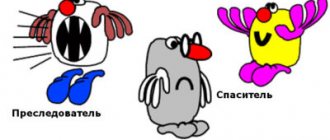Until what age is grimacing considered normal?
The antics have their reasons. The child will continue to grimace on several occasions.
- The child is unsure of himself and finds it difficult to communicate with peers. Uncertainty is typical not only for children, but also for adults. It often seems to us that the people around us are somehow superior to us, and we do not have the qualities necessary in life. It is especially difficult for a child who has started school but has not yet “fitted in” to it. This is why many children start to make faces. They try to attract attention, stand out in some way, and at the same time suppress their fear.
- The child receives little attention from adults. It is very important for a child that mom and dad are nearby, see his progress, study and play with him. If parents don’t pay attention, something needs to be done to make them pay attention. The baby thinks so. Grimacing is one of the ways to attract him. Even when parents are too busy, they will definitely be distracted to make a remark to their child. Therefore, antics gradually become a habit, which is difficult for children to get rid of.
- The older brother or sister is jealous of the younger ones .
The reason is about the same as in the previous case - the desire to get attention. Only here dad and mom, in the opinion of the older child, should break away from the younger one. He doesn’t understand why he now finds himself “on the margins,” because before everything was different.
- The child is very emotional or wants to be creative. Antics may be a consequence of “training” the offspring to restrain emotions. Now the baby is no longer rolling on the floor screaming, but simply pouting his lips with displeasure. He doesn't jump on the couch, squealing with delight, but he does have an ear-to-ear smile on his face, like a clown. Over time, you can teach him to smile even when he experiences the exact opposite emotions. But the child resists as best he can and wants to express emotions where and when he wants and how he wants. Also, he may have the makings of a future artist, and he begins to show them by making funny faces.
- Crooked doesn't want to get older. If he grimaces at the age of 4-5, this can be perceived as normal. But when a seven or eight year old is engaged in antics, this indicates a protracted childhood. He behaves like a child because his parents treat him that way, do not allow him to grow up, and deprive him of his independence.
A child feels small if he is treated like a baby and behaves accordingly. If the antics of small children can still touch, then the faces of a ten-year-old cause, at best, irritation. But the child can no longer stop; grimacing becomes his habit.
Possible reasons for bad behavior
To understand what to do about such behavior in your particular child, it is advisable to find out why he acquired such a habit in the first place. The most common reasons are:
- Lack of attention from adults. Sometimes very busy parents do not respond to numerous “Mom, look how I can do” or “Dad, play with me.” And the child, meanwhile, really needs them to devote time to him, play, study with him, make him feel important and needed. And then a simple solution to the problem comes to the rescue: to make faces. After all, if a child is fooling around, he will certainly attract someone’s attention. As a rule, this is exactly what happens (that is, this behavior is reinforced: previously busy parents actually break away from their work, even if only to scold their son/daughter), and gradually the habit of grimacing becomes permanent.
- Lack of self-confidence when communicating with peers. Lack of self-confidence is, in principle, a very common problem; many children (and what’s more, adults too) think that others are better, more successful, more talented, more worthy. In addition to this, if a child has recently started school and has not yet fit into the academic routine, he may feel like an outcast in this new community and social institution that is new to him. Adults have many ways to psychologically cope with this dissonance; children have fewer of them, and antics are one of the most popular. This is an opportunity to attract attention, outshine others and stand out from the crowd, and at the same time hide your fear of failure and rejection.
- A prolonged childhood. As was already said at the very beginning, making faces is a completely normal activity for young children. But if a child grows up, reaches preschool age, and his parents still treat him almost like a baby and do not allow him to be independent, he continues to perceive himself as a small child. But a child can and should make faces, everyone likes it, it touches everyone. And even the changed reactions of others do not allow one to get rid of the habit that has become ingrained into the subcortex.
- Jealousy towards a younger brother/sister. This is a special case of antics due to lack of parental attention. If there is a new addition to the family, it is obvious that the baby is given more time and effort: he is still much more defenseless and helpless than his older brother or sister. But from the position of this oldest child, the situation looks a little different: before this, mom and dad paid all their attention to him, but now they spend a lot of time with the youngest, and allocate forces to him on a residual basis. He can deal with this situation in different ways, and making faces is one of the most common ways. This is an attempt to somehow divert parental attention to oneself.
- Strong emotionality and a penchant for creativity. People who become artists behave quite uniquely from an early age. Sometimes it turns out that a child’s antics are, in fact, attempts to express himself, to demonstrate his acting abilities, which burst the creative personality from the inside and require a way out.
What to do if a child makes faces
From the very beginning, you should not encourage your offspring’s antics, even when you find them touching. And first, help him understand his own face. After all, it is also a mystery to him.
First, watch your own face. Remember that the child is your mirror. And he will be happy to “mirror” everything he sees. Mom smiles often, the smile will not leave the child’s face. Mom frowns and walks around with a dissatisfied face, and the baby will do the same.
Therefore, smile and joke more, play fun games with your child. Joint activities and cheerful laughter will be useful not only for him, but also for you. Smiling and laughter are powerful antidepressants that cannot replace any medication.
Second, help your son or daughter recognize and name emotions. There are different versions of the active listening technique. One of them is described, for example, by Julia Gippenreiter and is liked by many parents who have used it.
This is how it works. Take an upset child to the mirror and let him look at himself. If he's crying because you didn't go for a walk, you could say something like, “Look, your face is so sad! But we will quickly fix this. Let's start playing hide and seek with you. This is your favorite game. And what will your face look like?” Let the child himself name what his face will be like: cheerful, smiling... You also name not only negative emotions, but also positive ones: “You are all glowing with joy!”, “You are simply shining!”.
But don’t be too zealous in naming any facial movement. A three-year-old child already understands that other people are also capable of feeling. Therefore, you can train to translate emotions into words by watching passers-by on the street, watching movies and cartoons. Just so you know, up to 70% of information about people is revealed to us by their facial expressions. Over time, the child will begin to give up his seat in transport, seeing that the person looks tired. Or he won’t be afraid to give an injection if he notices how cheerful and kind the nurse’s face is.
Thirdly, turn your baby into a little actor. Put on home performances, stage songs. Theater not only allows you to gain self-confidence, but gives the child the opportunity to express emotions and make faces for his own pleasure. Talk to your child about where it is appropriate to make faces and where it is not. If you see that he is making faces at an unfamiliar grandmother, do not shout at him or insult him, just remind him of your conversation.
How to deal with the antics
Antics can piss off anyone, especially their parents. But first, it would be nice to understand why the baby loves to make faces so much. And having already found out the reason, take action. What can you do to direct your child's behavior in the right direction?
- Increase your time with your child. This is an effective way if he lacks attention. Now it seems to you that money, work, career are more important. But the hours spent with your baby are priceless. Some 4-5 years will pass, and time will be irretrievably lost. You may lose your child’s trust, and he will begin to build his life not according to the best scenario.
- Foster self-confidence in your child. There is no need to constantly remind the child that he is incompetent, still small, and only capable of ruining everything. Give him more tasks that he can handle. Praise him even if he doesn't succeed.
- Stop reacting to antics .
If you constantly pull your child back and make comments to him, he perceives your reaction as reinforcing and continues the outrage. Therefore, try not to react in any way, not even to smile, when he makes another funny face.
- Make it clear that antics can be compensated for with something positive. It is necessary for the baby to understand that making faces is stupid and ugly. You must prove that you really appreciate many of his qualities; you don’t like the antics of his legs at all. You are much more attracted to, for example, his plasticine crafts or drawings.
- Introduce creativity .
If you notice that your child is a creative person and the antics stem from his desire to create, give him this opportunity. Take me to a theater group, a drawing group. Let him show his creativity there and learn to comprehend beauty.
How to behave as parents with an annoyance
But still, how to behave in specific situations when it seems that patience is about to burst, and you want to scream at the child or give him a good dressing down.
.Try to fully concentrate on what you are doing and forget about the antics. The child will continue to grimace if he only gets a reaction from you. Watch TV, cook dinner, or knit a sweater as if nothing is happening around you.
Make about the same face. Let the child look at himself from the outside. Perhaps the baby will be surprised or laugh in response. But this is just the beginning. A few unpleasant and angry faces from pictures or their cartoons in your image will discourage him from making a face. He will understand that in response to antics he will get nothing but angry faces. You can ask older children or other family members to draw a caricature of the antics.
When you see that your child is not stopping what he is doing, hint that you are waiting for him to stop making faces so that you can do something interesting together, such as playing dominoes or reading fairy tales.
When communicating with your child, tell him more warm words about how kind, smart and wonderful he is. Tell him how much you love him, but you don’t like his antics at all.
Over time, the child will understand that he can attract attention to himself when he is doing something necessary and useful.
Why do children make faces?
There may be several reasons why a child behaves provocatively and constantly makes faces. Psychologists say that most often this behavior is caused by the child’s increased need for self-affirmation. When children want to become the center of the group, when they like that everyone is looking at them, they try to attract attention to themselves in these ways.
The child wants others to notice him, but at the same time he feels that he lacks some qualities and skills that his peers have, and the only way to somehow express himself is to grimace.
Also, clowning around can be an indicator of self-doubt. Very often, the mask of a jester is put on by those children who are ridiculed by their peers for being overweight, clumsy, excessively modest, or another quality that makes them different from others.
The need to attract attention is acutely felt by children who have a younger brother or sister. With the advent of the second child, all parental attention turns to him, and the eldest seems to fade into the background, which, naturally, offends him. He sees no other way to get out of this situation and his antics can be compared to a call for help: “Mom, finally pay attention to me!”
Sometimes children take on the buffoon role, on the contrary, spoiled by parental attention. If a child was constantly looked after, dust was blown off him and for a long time he was not allowed to show independence, by the age of 5-7 years he does not realize his social role, because he gets used to the fact that he always remains a baby in the family, to whom everything is possible. Such a child simply perceives the current situation as his destiny, gets used to the role and does not understand that he can behave differently.










